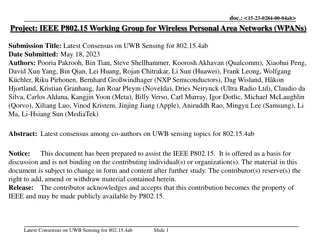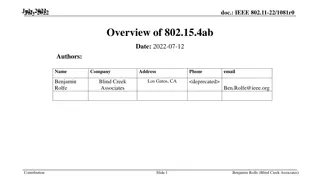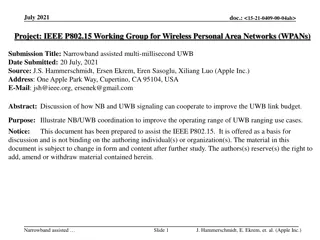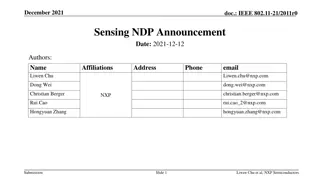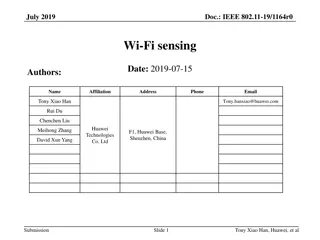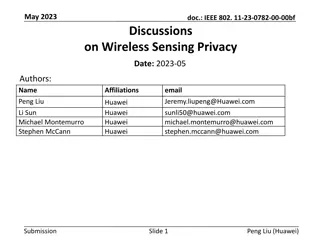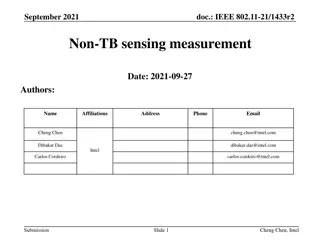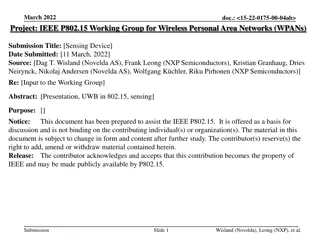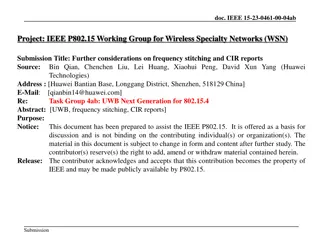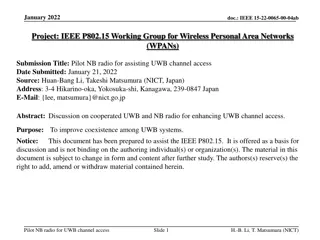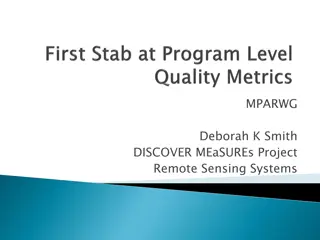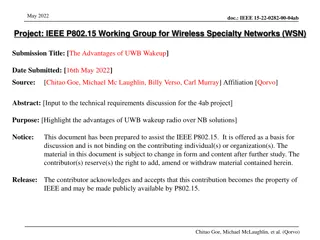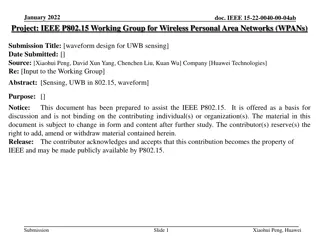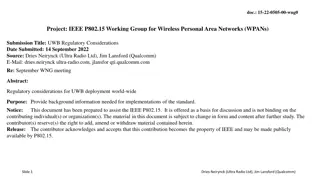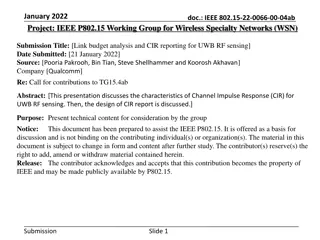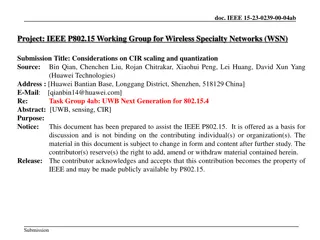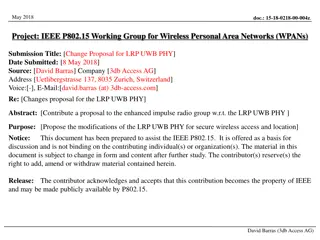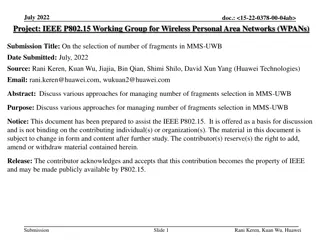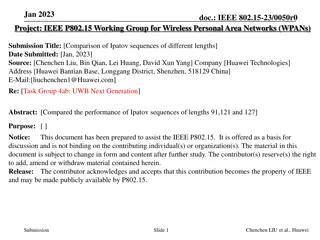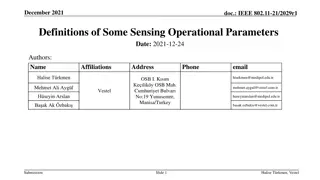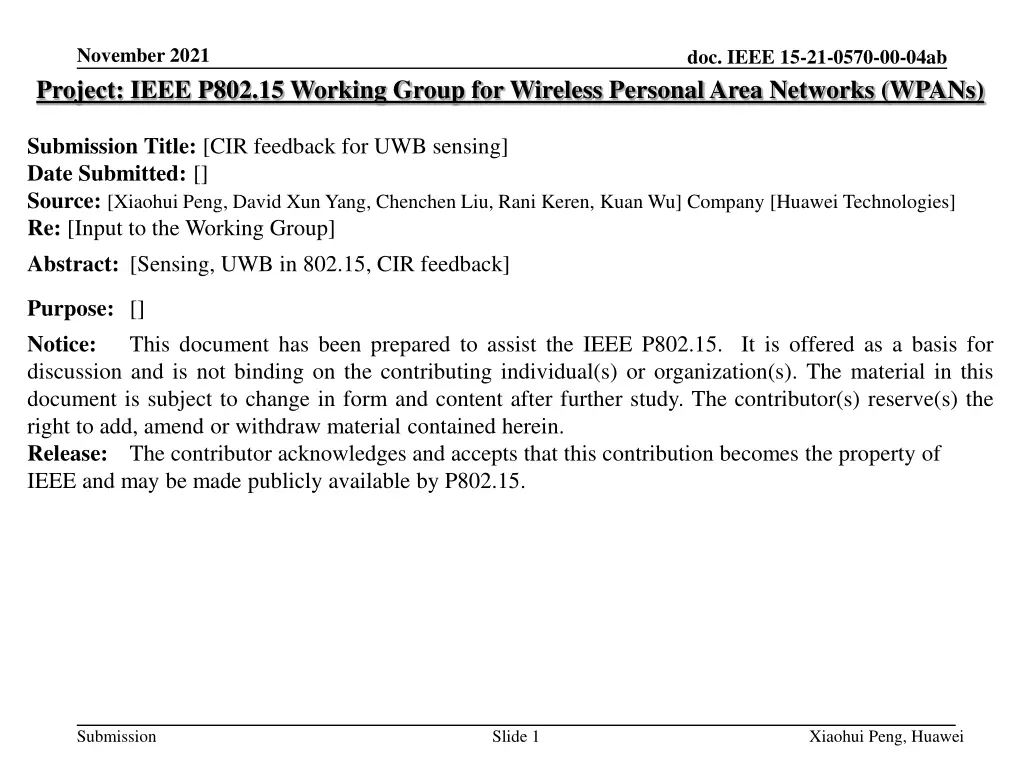
Enhancing UWB Sensing for IEEE 802.15 Working Group
Explore the innovative CIR feedback for UWB sensing within the IEEE 802.15 Working Group, focusing on applications for accurate range and reflection point measurements. Discover how this feedback contributes to improved sensing capabilities and high data-rate streaming in wireless personal area networks.
Download Presentation

Please find below an Image/Link to download the presentation.
The content on the website is provided AS IS for your information and personal use only. It may not be sold, licensed, or shared on other websites without obtaining consent from the author. If you encounter any issues during the download, it is possible that the publisher has removed the file from their server.
You are allowed to download the files provided on this website for personal or commercial use, subject to the condition that they are used lawfully. All files are the property of their respective owners.
The content on the website is provided AS IS for your information and personal use only. It may not be sold, licensed, or shared on other websites without obtaining consent from the author.
E N D
Presentation Transcript
November 2021 Project: IEEE P802.15 Working Group for Wireless Personal Area Networks (WPANs) doc. IEEE 15-21-0570-00-04ab Submission Title: [CIR feedback for UWB sensing] Date Submitted: [] Source:[Xiaohui Peng, David Xun Yang, Chenchen Liu, Rani Keren, Kuan Wu] Company [Huawei Technologies] Re: [Input to the Working Group] Abstract: [Sensing, UWB in 802.15, CIR feedback] Purpose: [] Notice: discussion and is not binding on the contributing individual(s) or organization(s). The material in this document is subject to change in form and content after further study. The contributor(s) reserve(s) the right to add, amend or withdraw material contained herein. Release: The contributor acknowledges and accepts that this contribution becomes the property of IEEE and may be made publicly available by P802.15. This document has been prepared to assist the IEEE P802.15. It is offered as a basis for Submission Slide 1 Xiaohui Peng, Huawei
November 2021 doc. IEEE 15-21-0570-00-04ab PAR Objective Proposed Solution (how addressed) Safeguards so that the high throughput data use cases will not cause significant disruption to low duty-cycle ranging use cases Interference mitigation techniques to support higher density and higher traffic use cases Other coexistence improvement Backward compatibility with enhanced ranging capable devices (ERDEVs) Improved link budget and/or reduced air-time Additional channels and operating frequencies Improvements to accuracy / precision / reliability and interoperability for high-integrity ranging Reduced complexity and power consumption Hybrid operation with narrowband signaling to assist UWB Enhanced native discovery and connection setup mechanisms Sensing capabilities to support presence detection and environment mapping Low-power low-latency streaming CIR feedback for UWB sensing Higher data-rate streaming allowing at least 50 Mbit/s of throughput Support for peer-to-peer, peer-to-multi-peer, and station-to- infrastructure protocols Infrastructure synchronization mechanisms Submission Slide 2 Xiaohui Peng, Huawei
November 2021 doc. IEEE 15-21-0570-00-04ab Motivation of CIR feedback For ranging application, it focuses on how to accurately measure the round trip time between node A and node B. In practice, TOA/TDOA techniques are used to detect the first path of the received signal, and the time stamps can be used to calculate the TOA/TDOA in this application. For sensing application, it focuses on how to accurately measure the range/angle/velocity of the reflection points. In this case, the CIR (channel impulse response) is needed to get reflection points information. Reflection point1 Node B Node B Node A Node A Reflection point2 Sensing application Ranging application Submission Slide 3 Xiaohui Peng, Huawei
November 2021 doc. IEEE 15-21-0570-00-04ab Motivation of CIR feedback Full-function device Reduced-function device Sensing packet CIR feedback packet Target Target Device C Responder Device A Responder Device B Initiator Device A Responder Use case1: only two nodes involved in sensing, but the capabilities of two nodes are not equal. Use case2: multiple nodes involved in sensing, and one node responsible for computation. Device B Initiator Submission Slide 4 Xiaohui Peng, Huawei
November 2021 doc. IEEE 15-21-0570-00-04ab Mathematical model of CIR If we do not take the bandwidth into consideration, the indoor radio propagation channel can be modeled as a linear time-varying filter with the following impulse response [1] : (?) ? ? ??? ? ? ??? ????(?) ? ?,? = ? ?=? ?0 ?3 ?2 ?1 where ? is the time delay, t refers to the impulse response at instance t and ? is the Dirac delta function. The parameters of the kth path are ??,??,?? and K, i.e. amplitude, time delay, phase and number of relevant multipath components, respectively. If we take the bandwidth into consideration, the time delay resolution is determined by the bandwidth ?? = ?/?, and the CIR can be expressed by: (?) ? ? ??+?/? ??? ????(?) ? ??????(?)?? ? ?,? = ?? ?/? ?=? ? where ?? is the center frequency. ? ?0 ?3 ?2 ?1 Submission Slide 5 Xiaohui Peng, Huawei
November 2021 doc. IEEE 15-21-0570-00-04ab Characteristics of CIR Dynamic living room scenario [2] - A target (35cm*35cm*1m) traveling in a straight path at a speed of 1 m/s inside the static living room as illustrated below. Y 7m Object Chair size material wood wood wood wood glass concrete concrete 1.5m 2.8m*1.05m*1m 1.05m*1.05m*1m 1.5m*0.7m*0.8m width=1m, height=2.5m Width=1.5m,height=1m~2.5m TX Chair with feet Table with feet Door Windows Wall Floor 3.5m,6m,0.8m 1.05m 0.7m 1.5m 2.8m 6m, 2m, 0.8m 7m htable=0.8m RX hsofa=1m 3.4944GHz 500MHz Frequency Bandwidth 1.05m hchair=1m 1.05m X 1m hroom=3m Submission Slide 6 Xiaohui Peng, Huawei
November 2021 doc. IEEE 15-21-0570-00-04ab Characteristics of CIR Main characteristics of CIR - As the target moves in the environment, Parameters (pathloss, AoA, AoD, and delay) of some rays are changing continuously over time; Some new rays are generated, TX Wall Target RX Some rays disappeared; like TX Target RX Since parameters of target-related rays are changing continuously over time, so we can compress the CIR in time domain to reduce the CIR transmission overhead. Submission Slide 7 Xiaohui Peng, Huawei
November 2021 doc. IEEE 15-21-0570-00-04ab CIR parameters feedback The CIR information is carried by the channel measurement feedback element, which includes: Subfield Size Meaning Element ID 8 bits Length 8 bits 8 bits Number of taps Ntap The amplitude (in-phase and quadrature) of tap 1 relative to the path with the strongest amplitude detected. 16bits Relative amplitude of tap 1 The amplitude (in-phase and quadrature) of tap 2 relative to the path with the strongest amplitude detected. 16bits Relative amplitude of tap 2 Tap amplitude The amplitude (in-phase and quadrature) of tap Ntap relative to the path with the strongest amplitude detected. 16bits Relative amplitude of tap Ntap Submission Slide 8 Xiaohui Peng, Huawei
November 2021 doc. IEEE 15-21-0570-00-04ab CIR parameters feedback Subfield Size Meaning The delay of tap 1 relative to the path with the shortest delay detected. 8bits Relative delay of tap 1 The delay of tap 2 relative to the path with the shortest delay detected. 8bits Relative delay of tap 2 Tap delay The delay of tap Ntap relative to the path with the shortest delay detected. 8bits Relative delay of tap Ntap 8bits AOA of tap 1 The AOA of tap 1 8bits AOA of tap 2 The AOA of tap 2 AOA (Azimuth angle of arrival) 8bits AOA of tap Ntap The AOA of tap Ntap 8bits ZOA of tap 1 The ZOA of tap 1 8bits ZOA of tap 2 The ZOA of tap 2 ZOA (Zenith angle of arrival) 8bits ZOA of tap Ntap The ZOA of tap Ntap Submission Slide 9 Xiaohui Peng, Huawei
November 2021 doc. IEEE 15-21-0570-00-04ab CIR parameters feedback-use case 1 Note: In this case, device A is a full-function device, and device B is a reduced-function device. Step 1: Device A sends a PPDU for sensing, a preamble and an optional STS field are contained in this PPDU. Step 2: Device B receives the sensing PPDU sent by device A, and calculates the CIR via preamble or STS sequence. Step 3: Device B feedbacks the CIR between device A and device B to device A. Full function device A CIR feedback 1 Sensing PPDU Reduced function device B Sensing PPDU CIR feedback 1 Submission Slide 10 Xiaohui Peng, Huawei
November 2021 doc. IEEE 15-21-0570-00-04ab CIR parameters feedback-use case 2 Note: In this case, device A is a full-function device, and device B/C can either be a full-function or reduced function device. Step 1: Device A sends a PPDU for sensing, a preamble and an optional STS field are contained in this PPDU. Step 2: Device B receives the sensing PPDU sent by device A, and calculates the CIR via preamble or STS sequence. Step 3: Device B feedbacks the CIR between device A and device B to device A. Step 4: Device C receives the sensing PPDU sent by device A, and calculates the CIR via preamble or STS sequence. Step 5: Device C feedbacks the CIR between device B and device C to device A. Device A CIR feedback 2 CIR feedback 1 Sensing PPDU Device B CIR feedback 1 Sensing PPDU Device C Sensing PPDU CIR feedback 2 Submission Slide 11 Xiaohui Peng, Huawei
November 2021 doc. IEEE 15-21-0570-00-04ab Summary In this presentation, some aspects of CIR feedback in UWB are introduced, we have the following observations: - Since parameters of target-related rays are changing continuously over time, so we can compress the CIR in time domain to reduce the CIR transmission overhead. - The CIR information is carried by the channel measurement feedback element, which includes amplitude, time delay, AOA, and ZOA. Submission Slide 12 Xiaohui Peng, Huawei
November 2021 doc. IEEE 15-21-0570-00-04ab References 1. Irahhauten Z. Ultra-wideband wireless channel: measurements, analysis and modeling[J]. 2009.. 2. Channel modeling for WLAN Sensing indoor scenario, IEEE 802.11- 20/1893r1. Submission Slide 13 Xiaohui Peng, Huawei

